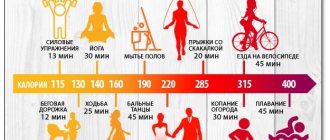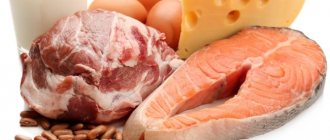What determines the time food spends in the stomach?
When consuming culinary delights, it is important to consider that the benefits, time of absorption by the body and the release of nutrients depend on many factors. Freshness, method of preparing the additive, compatibility - everything is important and requires special attention.
The main stage of digestion of foods is carried out in the stomach and can take from 30 minutes to 6 hours, while the processing period until defecation takes approximately 20 hours.
The speed of digestion is determined by the moment when food enters the intestines; to simplify the task, consumer products must be properly systematized:
| Group | Ingredients | Length of time (in hours) |
| Quickly digestible | Juices of vegetables, fruits, vegetables, berries, fruits (bananas, avocados are not included in the list). | 0,45 |
| Average digestion | Eggs, poultry, seafood, dairy products (cottage cheese, hard cheese are not included in the list). | 1 – 2 |
| Prolonged digestion | Potatoes, mushrooms, nuts, legumes, cottage cheese, hard cheese, cereals, bread. | 2 – 3 |
| Not digestible | Canned vegetables, stewed meats, coarse pasta, mushrooms, tea, coffee with added milk, protein foods of animal origin. | 3 – 4 or excreted without digestion (pork 6 hours) |
Considering the digestion time of food can significantly improve your health. Ignoring this indicator, a person carries an impressive amount of rotting products, which adversely affects health and causes diseases of the digestive system and cardiovascular system. Moreover, poor, unhealthy nutrition negatively affects life expectancy.
In order for recycling to be complete, it is important to follow simple rules:
- By simultaneously consuming foods that require different intervals for digestion, the body is subjected to excessive stress, which makes no sense. Boiled potatoes eaten on their own could enter the small intestine in an hour, when in combination with pork they are doomed to be digested for a long 6 hours.
- The best solution for preparing your favorite dishes is a combination of products that require the same amount of time to process. This will allow you to spend a little more time than with mono nutrition, but this approach is most suitable when mixing.
- When using vegetable oils as a salad dressing, it should be taken into account that the processing time in the stomach will increase several times (2-3). Oil creates a coating on vegetables, which complicates the processing of salad components by gastric juices and enzymes.
- You should not drink food immediately after eating it with teas, water, or any drinks. After a meal, it is necessary to wait until the food passes from the stomach to the intestines. If the rule is violated, the saturation of gastric juice decreases, digestion worsens and the load on the digestive system increases. Water, diluting food, prevents complete digestion; because of this, whole fragments of food penetrate into the intestines and, as a result of the active action of putrefactive microorganisms, expose undigested food to decomposition and fermentation.
- By consuming water in its pure form, without additional inclusions, it goes directly into the intestines without delay.
- Any meal does not tolerate fuss. When consuming any product, you must chew the food carefully and slowly. Thanks to this simple action, you can significantly speed up the digestion process, since the stomach will not need to expend energy on grinding ingredients, and enzyme processing occurs thoroughly in the oral cavity.
- When eating food of animal origin that is rich in protein, it is important to understand that in a heated state it is digested for 2-3 hours, then goes to the thin section to continue the breakdown of valuable components from food components.
- Less time is spent on digesting cold dishes; proteins do not have time to be absorbed and enter the small intestine, where they create favorable conditions for the proliferation of bacteria, which subsequently cause discomfort in the digestive system (gas formation, constipation). It is the consumption of cooled or chilled food that leads to the accumulation of excess weight and the acquisition of a diagnosis of obesity.
- The best time to ferment food is lunchtime. If there is a need to mix incompatible products, it is better to do this during the day. Breakfast and dinner do not fully utilize the body's reserves. In the morning he has not yet woken up, in the evening he is already ready for sleep.
- Night time is a period of rest. During this period, food lies in the stomach as dead weight until the moment of awakening. Deposits of products undergo decomposition and have a negative effect on the body.
Drinking milk for gastritis
Gastritis is an inflammation of the stomach lining.
Symptoms can be different, and only a doctor is able to make the correct diagnosis and prescribe medication, depending on the form of the disease. However, to speed up the healing process, it is very important to follow a proper diet. And it, in turn, directly depends on the type and course of the disease. There are gastritis with high and low acidity, they occur in different ways and require individual treatment not only with medications, but also with dietary nutrition, so the question often arises: is it possible to consume dairy products and drink milk with gastritis.
The answer is very simple: milk can be added to your diet in both cases, since it contains calcium and easily digestible proteins, which are indispensable for restoring damaged gastric mucosa. In addition, milk is rich in vitamin E, which neutralizes the effect of hydrochloric acid. However, you should consume dairy products with gastritis with caution, following certain rules.
Gastritis with high acidity
Gastritis with a high level of acidity is characterized by the following symptoms: heartburn, nausea and vomiting, sour belching. In general, treatment is aimed at reducing acidity levels, as well as limiting foods that cause excessive stomach acid production and further damage the inflamed stomach lining. Therefore, you can drink milk for gastritis with a high level of acidity, unless it is low-fat. But dairy products with a high level of acidity, such as kefir and sour cream, are undesirable products for gastritis. In general, it is better to limit all fermented milk products.
Goat's milk for gastritis with high acidity
During the diet, special attention should be paid to such a product as goat milk, which has an exceptional composition.
Firstly, goat milk contains a special substance - lysozyme, which has wound-healing properties and can destroy Helicobacter Pylori bacteria. Secondly, goat milk protein, unlike cow’s milk, contains a huge amount of albumin, so it is easily broken down into small components and is well absorbed by the human body, minimizing the occurrence of any digestive system disorders. Thirdly, goat milk contains little lactose, so it can be consumed by almost everyone without exception, but you should start drinking it little by little, gradually increasing the amount to make sure that there is no individual intolerance. Fourthly, goat milk can quickly neutralize the harmful effects of hydrochloric acid on the gastric mucosa, without causing discomfort such as bloating, nausea and heartburn. For gastritis, it is recommended to drink goat milk every morning before meals. You need to drink a glass of unboiled milk on an empty stomach, then during the day you can drink another 1-2 glasses.
Gastritis with low acidity
With gastritis with a low level of acidity, rotten belching, heaviness in the stomach, and bloating are observed, this is due to a weak digestion process and insufficient breakdown of food in the intestines due to the low level of acidity. In this case, consuming whole milk is not recommended. You can drink it, adding it, for example, to tea or coffee, or use it as a base for preparing various dietary porridges. But dairy products such as kefir, fermented baked milk and yogurt will be very useful for this type of gastritis. You can make various casseroles or soufflés from fresh cottage cheese. It is also worth making sure that all dishes look appetizing and make you want to try them, for example, prepare a milkshake from non-acidic berries and fruits and serve it beautifully. In this case, gastric juice will be produced in the required quantity.
Table - how much food is digested in the human stomach
| Ingredients | Time spent on digestion in the intestines (hours) |
| Raw plant foods: | |
| Bananas | 0,45 – 0,50 |
| Grapes, orange, grapefruit | 0,30 |
| Mushrooms | 5 – 6 |
| Mandarin | 2 |
| Carrots, turnips, parsnips | 0,50 |
| Fruits and berries with high water content | 0,20 |
| Persimmon | 3 |
| Apple, cherry, peach | 0,40 |
| Kiwi | 0,20 – 0,30 |
| Animal products: | |
| Yogurt | 2 |
| Kefir | 1,4 – 2 |
| Ryazhenka | 2 |
| Homemade cheese | 0,90 |
| Milk | 2 |
| Cottage cheese | 2,5 |
| Low fat cottage cheese | 2,4 |
| Chicken meat, chicken breast | 1,5 – 2 |
| Beef | 3 – 4 |
| Pork | 3,5 – 2 |
| Semi-finished products (dumplings) | 3 – 3,5 |
| Fish depending on the variety | 0,30 – 0,80 |
| Cheese | 3,3 |
| Brynza | 0,90 |
| Egg raw | 0,45 |
| Other products: | |
| Water | Without any additives, it penetrates immediately into the small intestine |
| Buckwheat | 0,60 – 0,80 |
| Early potatoes | 2 |
| White cabbage (pickled) | 4 |
| Pasta | 3,2 |
| Honey | 1,2 |
| Oatmeal on water | 0,60 – 0,80 |
| Milk oatmeal (cereal) | 4 |
| Milk oatmeal (from flakes) | 2, 5 |
| Rice | 0,60 – 0,80 |
| Vegetable soup | 0,20 |
| Bread taking into account the type of flour | 3,1 – 3,3 |
| Tea | 1 |
The conclusion is obvious. The residence time of food in the stomach is ambiguous, the value can change. It can be adjusted and controlled. Maintaining a healthy body is not difficult, just be careful about what you put into your mouth. Food should be wholesome, healthy and not create discomfort. By eating rationally, you can avoid feeling hungry between meals.
Many people, even those who monitor their diet, do not take into account such a factor as the time it takes for food to be digested in the stomach and what it affects, so in this article we will look in detail at how long it takes for food to be digested in the human stomach and what affects the speed of digestion.
Melons and citrus fruits
These are the smallest food groups. But the table also includes them.
Digestion of food in the human stomach, or more precisely, its speed, depends on various factors. In particular, from calories. There are few of them in citrus fruits. Therefore, orange, tangerine and grapefruit are digested in two hours. A lemon – in 1.3 hours. It has the least amount of sugar and calories. It is for this reason that those who want to get rid of extra pounds are advised to consume the maximum amount of citrus fruits.
Of the melons, pumpkin requires the most time - 3.1 hours. Watermelon is digested in 2.3 hours, and melon – in 2.4 hours.
What determines the rate of food digestion over time?
- Drinking water and other liquids during meals. It is not recommended to drink water and drinks during meals, as they dilute the gastric juice and the digestion time of food increases (or the food is not completely digested).
- Many products after heat treatment (cooking, frying, stewing) take longer to be absorbed in the human body (the time for assimilation of products increases).
- Cold food is digested faster over time.
- Food eaten at lunch is digested faster than food eaten in the morning and evening.
- The speed of digestion in the stomach and absorption in the body is greatly influenced by the type and amount of food consumed, since different foods are absorbed at different speeds (from several minutes to several hours), and when they are mixed, the digestion time can increase.
Of the listed factors that significantly influence how quickly the food eaten and drinks drunk will be digested, let us dwell in more detail on the speed of digestion of all products separately and consider how many hours various foods are digested (meat, fish, cereals, vegetables, fruits, etc. .) in the human stomach.
Rules for creating a diet
We figured out how long it takes to digest this or that food. Why is this necessary? To properly plan your diet. When thinking over the menu for the coming week, it is advisable to follow the following rules:
- Try to include foods from categories 1 or 2 in your diet. They are absorbed much faster. This means that your digestive system is not overloaded, the body spends less energy on digestion, it is spent on something else, no less important.
- People who have gastrointestinal diseases are also better off choosing light foods that are digested much faster, that is, from categories 1 and 2.
- In the evening, it is also advisable to eat food that belongs to these categories. At night, the human body rests, including its gastrointestinal tract, so some of the food will remain in the stomach until the morning, and by then it will have already had time to ferment.
- You shouldn't eat foods from category 4 too often.
- If you are creating a menu, try not to mix foods that differ greatly in digestion time, as you will overload the stomach.
- Remember that if you add various oils to your food, for example, eat a salad with sunflower oil, the period of food digestion increases by about 2-3 hours.
- If you heat-treat foods, that is, boil or fry them before eating, their original structure changes, as does the digestion time, it increases by 1.5 times.
- Many people like to wash down their food. If the food has been diluted with any liquid, then the concentration of digestive gastric juice is reduced, so processing the food may also take longer
Table: how much food is digested in the human stomach
| The product's name | Product digestion time |
| Water and drinks | |
| Water (drink on an empty stomach) | immediately enters the intestines |
| Vegetable and fruit juices | 15-30 minutes |
| Tea | About 60 minutes |
| Broth (vegetable, chicken, meat) | 20-40 minutes |
| Vegetables and greens | |
| Jerusalem artichoke (earthen pear) | 1.5-2 hours |
| Potatoes (new potatoes) | 2 hours |
| Boiled potatoes | 2-3 hours |
| Fried potato | 3-4 hours |
| Carrots (fresh) | 50-60 minutes |
| White cabbage (fresh) | 3 hours |
| Sauerkraut | 4 hours |
| Beetroot (boiled) | 45-55 minutes |
| Tomatoes | 30-40 minutes |
| Cucumber | 30-40 minutes |
| Bulgarian pepper | 30-40 minutes |
| Salad | 30-40 minutes |
| Greenery | 30-40 minutes |
| Zucchini (boiled) | 40-50 minutes |
| Corn (boiled) | 40-50 minutes |
| Corn (canned) | partially digested for at least several hours |
| Salads dressed with vegetable oil | 50-60 minutes |
| Mushrooms | 5-6 hours |
| Fruits and berries | |
| Orange | 30 minutes |
| Grapefruit | 30 minutes |
| Grape | 30 minutes |
| Cherry | 40 minutes |
| Peach | 40 minutes |
| Pear | 40 minutes |
| Apple | 40 minutes |
| Kiwi | 20-30 minutes |
| Banana | 45-50 minutes |
| A pineapple | 40-60 minutes |
| Mango | 1.5-2 hours |
| Legumes | |
| Lentils | 3 hours |
| Peas | 2-2.5 hours |
| Green peas | 2-2.5 hours |
| Beans | 3 hours |
| Soybeans | 2 hours |
| Dried fruits and nuts | |
| Dates | 2 hours |
| Raisin | 2 hours |
| Prunes | 3 hours |
| Nuts (walnuts, pine, hazelnuts, peanuts) | 3 hours |
| Seeds (seeds) of sunflower, pumpkin, sesame | 2 hours |
| Cereals and porridges | |
| Millet | 60-80 minutes |
| Rice | 60-80 minutes |
| Buckwheat (buckwheat porridge) | 60-80 minutes |
| Barley porridge | 60-80 minutes |
| Oatmeal | 60-80 minutes |
| Milk and dairy products | |
| Milk | 2 hours |
| Fermented milk drinks (for example, kefir) | 60 minutes |
| Homemade cheese | 90 minutes |
| Brynza | 90 minutes |
| Low-fat cottage cheese | 90 minutes |
| Fat cottage cheese | 2 hours |
| Hard cheese | 4-5 hours |
| Yogurt | 2 hours |
| Ice cream | 2-2.5 hours |
| Meat | |
| Chicken meat | 1.5-2 hours |
| Turkey | 2 hours |
| Pork | 3.5-5 hours |
| Beef | 3-4 hours |
| Mutton | 3-3.5 hours |
| Salo | At least 5-6 hours |
| Dumplings | 3-3.5 hours |
| Fish and seafood | |
| Lean fish (eg cod) | 30 minutes |
| Fatty fish (herring, trout, salmon) | 50-80 minutes |
| Shrimps | 2-2.5 hours |
| Seafood Cocktail | 2.5-3 hours |
| Flour products | |
| Bread (wheat, rye) | 3-3.5 hours |
| Pasta, spaghetti | 3-3.2 hours |
| Eggs | |
| Egg white | 30 minutes |
| Egg yolk | 45 minutes |
| Scrambled eggs (fried eggs), omelet | 2-3 hours |
| Boiled egg | 2-2.5 hours |
| Sweets | |
| Chocolate | 2 hours |
| Honey | 1-1.5 hours |
| Marshmallow | 2 hours |
| Halva | 3 hours |
| Gum | not digested (leaves the body within 12-36 hours) |
Fruits and vegetables
30-60 minutes to digest on average.
. Digesting fruits requires almost no energy or enzymes.
Fruit and vegetable juices and vegetable broths - 20-30 minutes.
Semi-liquid juices, such as pureed vegetable or fruit salad - 20-30 minutes. For example, a glass of freshly squeezed orange juice will leave our stomach within 20 minutes after you drink it.
Juicy fruits:
oranges, apples, pears, plums and so on. For example, a couple of eaten juicy and aromatic oranges will leave the stomach in 30-40 minutes. Grapefruits, grapes - 30 minutes. Apples, pears, peaches, cherries, etc. - 40 minutes
Fleshy fruits and dried fruits:
Bananas, figs, dates will take longer to pass through the stomach than juicy fruits, but still very quickly compared to the products that come next. Watermelon - 20 minutes. Melons - 30 minutes.
Raw mixed vegetable salads
- tomatoes, lettuce, cucumber, celery, green or red pepper, other juicy vegetables - 30-40 minutes
Leafy vegetables
– spinach, chicory, kale – 40 minutes
Zucchini, broccoli, cauliflower, green beans, pumpkin, corn on the cob
x - 45 minutes
Roots
- carrots, beets, parsnips, turnips, etc. — 50 minutes
So, what does food digestion depend on?
Conventionally, three categories of food mixing can be distinguished:
For clarity, let’s consider products or food conditionally divided into groups according to the time of its digestion.
First group; absorption time no more than 45 minutes. These include mainly various carbohydrates.
- — Fruits: watermelon, melon, orange, grapefruit, grapes — 30 min.
- - Cherry, apple, peach, pear, sweet cherry, apricot - about 40 minutes.
- - Vegetables: raw mixed vegetables - 30-45 min.
- - Broths and mixed salads with fruit - about 30 minutes.
- — Fruit and vegetable juices are digested in 15-20 minutes.
The second group consists of protein products with a small amount of fat. Digestion time is no more than 2 hours.
- — Egg (completely) — 45 minutes
- — Fish (not fatty varieties) — 30 minutes
- – Fish (salmon, trout, herring, fattier fish) – 45-60 minutes
- — Chicken (without skin) — 1-2 hours
The third group includes products that contain complex carbohydrates and starch, the absorption time is about 2-3 hours.
- - potato;
- - porridges from all types of cereals;
- - mushrooms;
- - cottage cheese from whole milk - 125 minutes;
- - seeds (sunflower, pumpkin, sesame) - about 2-3 hours;
- - nuts, almonds, peanuts (raw), pecans - 2.5-3 hours;
- - legumes.
Fourth group, the digestion time of these products is more than 3-4 hours, while many of them are excreted from the body without being digested.
- — Coffee and tea with milk;
- — Fish and canned fish;
- — Meat and various stews, pates, etc. (lamb and beef 3-4 hours, pork 5-6 hours).
- — Hard cheese made from whole milk — 4-6 hours.
- — Pasta made from durum wheat.
Cereals, cereals and legumes
Digestion time for grains
Concentrated carbohydrates - cereals and grains
. The digestion time of cereals and grains in the stomach increases sharply. Therefore, it is recommended to eat fruits on an empty stomach, separately from cereals and cereals. A plate of regular porridge leaves the stomach only after 4-5 hours!
Brown rice, millet, buckwheat, corn flour, oats, pelovka
— 90 minutes
Durum wheat pasta:
3 hours
Semi-concentrated carbohydrates
- starches, Jerusalem artichoke, acorns, corn, potatoes, Jerusalem artichoke, yams, chestnuts - 60 minutes
Digestion time for legumes
Beans and legumes. Regular peas and chickpeas, lentils, beans (white, red, black) are digested in an hour and a half. Soybeans - 2 hours
Cereals or legumes of one type: 2.5-3 hours. Mixture of grains and/or legumes (no more than two types): 3-3.5 hours. Mixture of grains and/or legumes (more than two types): more than 4-5 hours. .
Table of time for digestion of food in the stomach.
Below is a table in which you can see a list of products and their absorption time.
| Products | Digestion time |
| Water | Immediately enters the intestines |
| Fruit juice | 15-20 min |
| Vegetable juice | 15-20 min |
| Vegetable broth | 15-20 min |
| Raw vegetables | 30-40 min |
| Vegetable salads without oil | 30-40 min |
| Vegetable salads with vegetable oil | up to 1 hour |
| Fruits containing a lot of water and berries | 20 minutes |
| Orange, grapes, grapefruit | 30 min |
| Apples, cherries, peaches, pears | 40 min |
| Boiled vegetables | 40 min |
| Cabbage, zucchini, corn | 45 min |
| Carrots, turnips, parsnips | 50 min |
| Potatoes, Jerusalem artichoke | 1.5-2 hours |
| Porridge: buckwheat, rice, millet | 2 hours |
| Legumes | 2 hours |
| Dairy | 2 hours |
| Nuts | 3 hours |
| Sunflower seeds, pumpkin | 3 hours |
| Egg | 45 min |
| Fish | 1 hour |
| Poultry meat | 2.5-3 hours |
| Beef | 3 hours |
| Mutton | 3 hours |
| Pork | 5.5-6 hours |
Useful tips on proper nutrition.
I want to end my article with interesting facts; I believe that they can change our eating behavior and at the same time improve our health.
You should know it:
- — water drunk on an empty stomach enters the intestines within a few minutes.
- - fats in the form of oils are not absorbed in the body, and by enveloping food, they complicate its dissolution by stomach acid.
- - Do not drink water, tea or other drinks when there is food in the stomach. Additional liquid entering the stomach dilutes the gastric juice, which makes it more difficult to digest food. This leads to the fact that by increasing the load on the gastrointestinal tract, undigested foods enter the intestines along with liquid and begin to ferment and even rot.
- — to speed up the digestion process and improve it, you need to chew your food thoroughly.
- — protein foods are best consumed warm, since warm food is digested in about 2-3 hours, and the time for protein breakdown is also within this time.
- — if nuts and seeds are soaked in water overnight and then crushed, they are digested faster.











